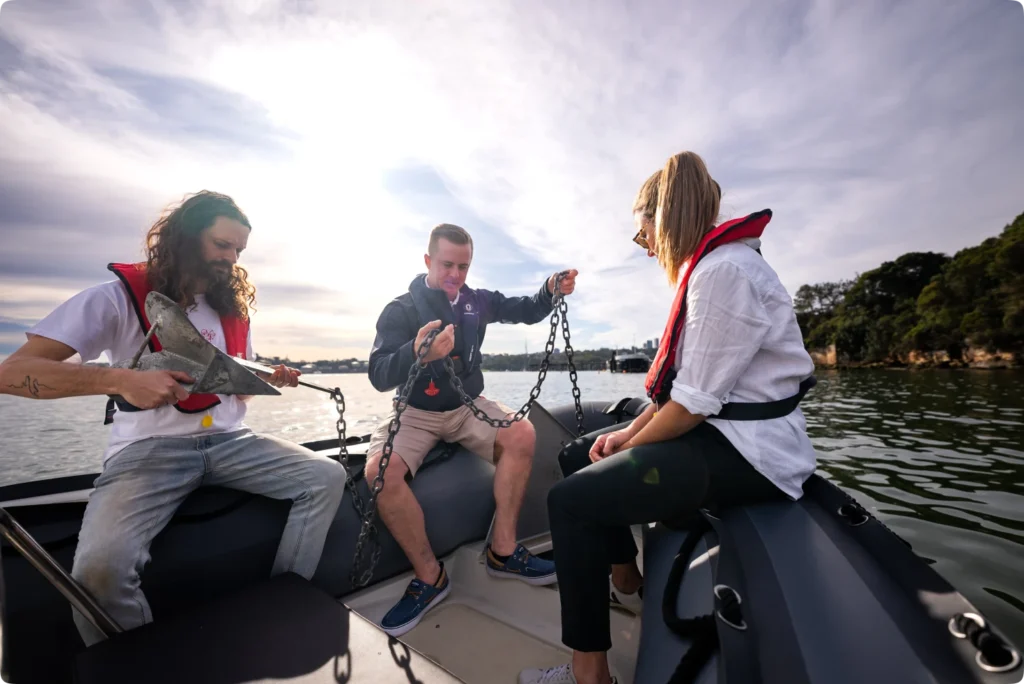Learning how to anchor your boat is an essential part of any smart boater’s repertoire. In this guide you’ll learn how to anchor your boat safely and effectively.
Check out these tip to anchor your boat safely and effectively:
- Find the perfect spot to drop anchor, keeping clear of other boats and a safe distance from the shore line.
- Work out what the depth of the water is. Depending on the depth this will determine what scope you will need. Scope is defined as the ratio of the length of your anchor rode (Rode is the combination of rope and chain that connects your anchor to your boat). Depending on your anchor and rode setup – a 3:1 scope plus the height of your bow from the waterline is normally fine for winds of up to 15 knots. However, a larger scope is needed especially if conditions worsen, or you plan to stay overnight. Therefore, you will need a scope of 4:1, 5:1, 6:1 or 7:1 to get you out of trouble.
More scope means less strain on the anchor, which decreases the chances of dislodging the anchor and drifting.
In simple terms: for every 1 metre of water you will need a minimum of 3m of chain and rope plus+ the height of your bow from the waterline.
3. Point the bow of your boat into the wind, or current; whichever is stronger. Slowly drop your anchor overboard from the bow. Ensure the bitter end of the anchor rode is connected to the boat.
4. Reverse back until you feel a strong tug on the anchor rode, indicating the anchor has dug into the sea bed.
5. Let the boat settle for a few moments, then pick 3 unmoving reference points to ensure the boat is not drifting. You can also use an electronic anchor alarm, which is great for overnight anchoring.
How to retrieve your anchor:
- Slowly motor toward the anchor while pulling in the rode and once you are directly over the anchor it should pull free.
Oh no! What if my anchor is stuck?!
Firstly, try not to panic!
2. Try the above step a few times. Use the natural movement of the boat on the waves to help free the stuck anchor.
3. Drive over the anchor in the opposite direction you laid the anchor rode, being careful not to get it stuck around your propellers.
4. If you’ve tried it all and the anchor won’t come loose, sometimes it’s best to cut the rope and buy a new anchor.
The best way to ensure you’re able to anchor successfully is to first learn the process at the hands of an expert.
Book your private boat training session
How to choose the right anchor for your boat…
There are anchors for every type of sea bed: rocky floors, sea grass, sand, mud, and permanent moorings. When deciding which anchor is right for your boat, consider the type and weight of your vessel, as well as the type of sea bed you are planning to anchor in. We’ve linked a video for you too if you’d like the visualise the different anchors available for your boat.
Common Types of Anchors:

(A) The Danforth anchor
Lightweight and holds very well in mud and sand, as well as rocky bottoms, if set carefully.
(B) The Plow anchor
Has superior holding on most sea beds, including grass and weeds however does not hold well on rocky bottoms.
(C) The Mushroom anchor
Buries well and holds best in sand or mud, but may be difficult to retrieve.
(D) The Bruce or claw anchor
A good burying type and holds well in sandy bottoms and mud.
(E) The Navy or Admiralty anchor
Reliable and familiar to most people, but can be awkward to stow on board.
(F) The Grapnel
Small and easy to stow and is great for small vessels and open boats.
At Boat Wise Sydney, we offer private training sessions on your boat or ours. We have experience across a large variety of vessels with a strong focus on building confidence when conducting our private boat training sessions.
